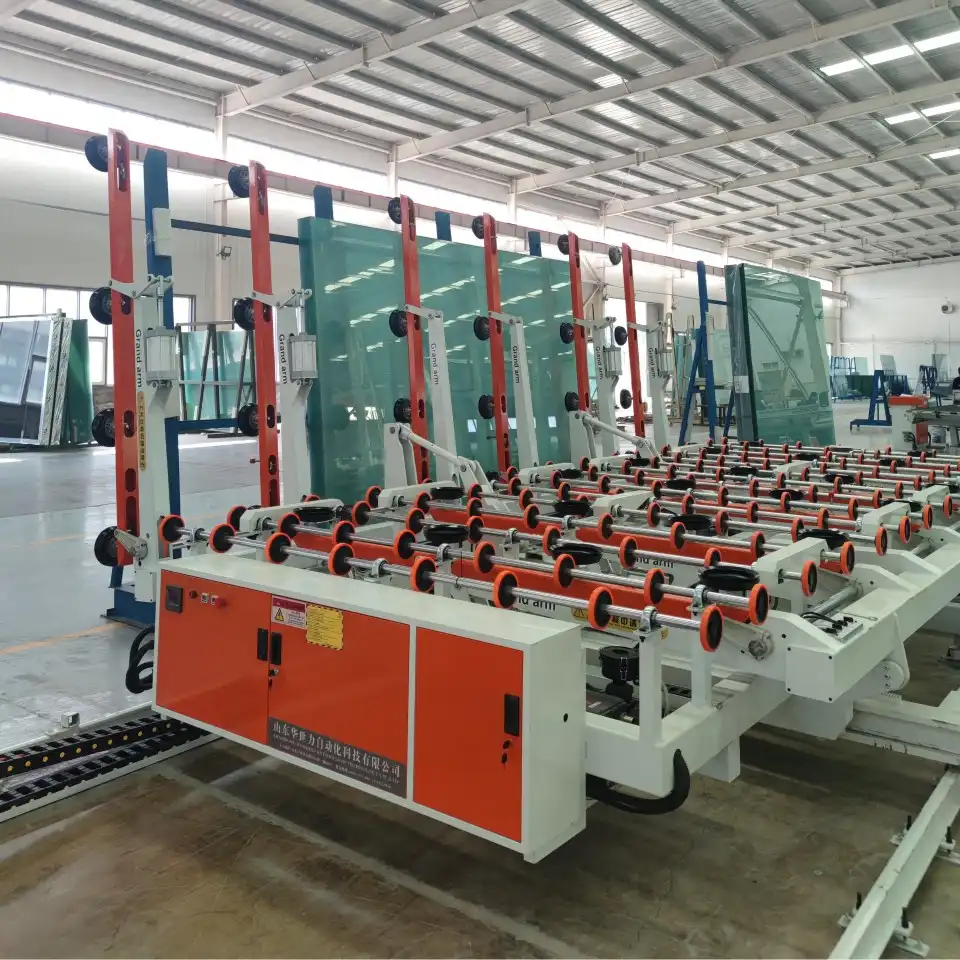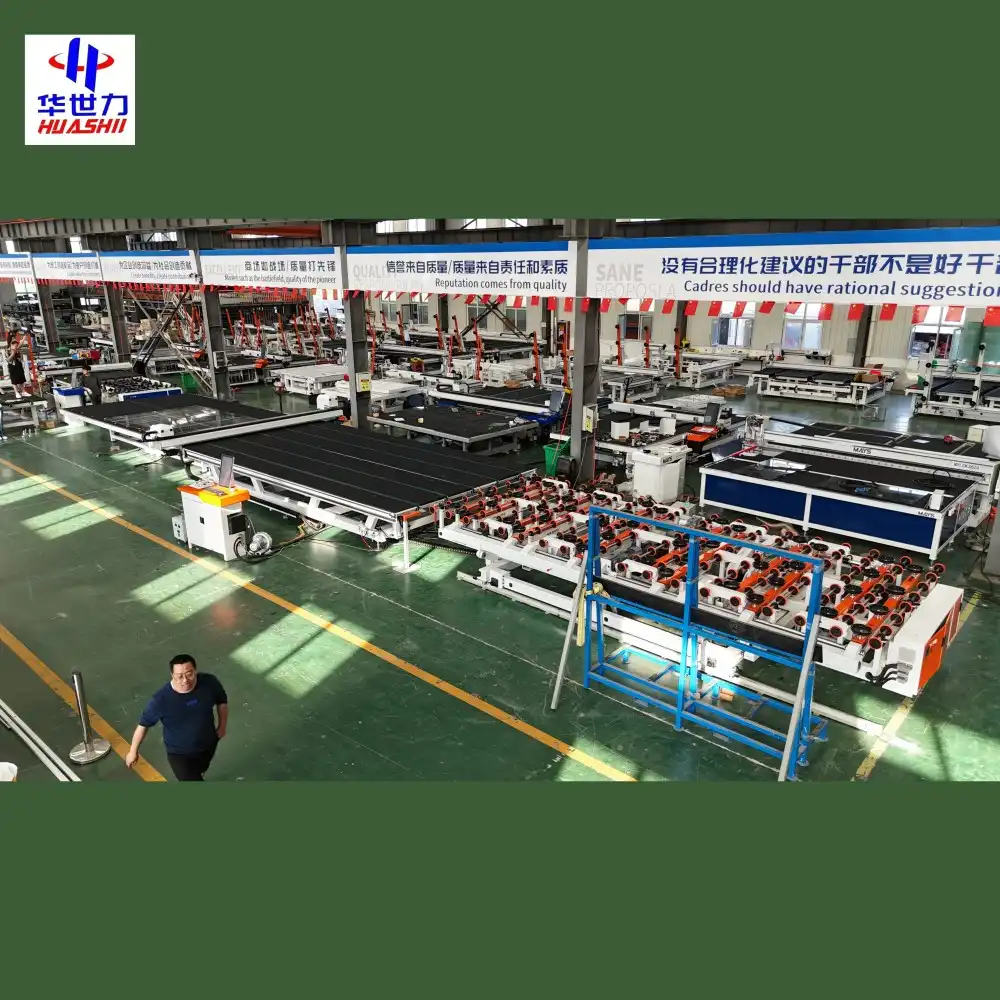The world of glass manufacturing and processing has been revolutionized by the advent of integrated glass cutting machines. These sophisticated pieces of equipment have transformed the way industries approach glass cutting, offering unprecedented precision, efficiency, and versatility. In this comprehensive guide, we'll delve into the inner workings of an integrated glass cutting machine, exploring its operating principles, step-by-step processes, and the crucial role of sensors in these cutting-edge systems.
What is the operating principle of an integrated glass cutting machine?
At its core, an integrated glass cutting machine operates on a principle that combines mechanical precision with advanced computerized control. The machine utilizes a cutting head, typically equipped with a diamond or carbide wheel, to score the glass surface along predetermined paths. This scoring creates a controlled stress point in the glass, which can then be cleanly separated along the score line.
The integration aspect of these machines comes from their ability to seamlessly combine multiple processes and technologies into a single, cohesive system. This integration may include:
- Computer Numerical Control (CNC) systems for precise movement and cutting
- Automated glass loading and unloading mechanisms
- Optical recognition systems for glass positioning and quality control
- Cutting optimization software to maximize material usage
- Automated lubrication systems for the cutting wheel

The synergy of these components allows for a high degree of automation, reducing human error and increasing productivity. The machine's operating principle is based on the precise control of several key parameters:
- Cutting speed: The rate at which the cutting head moves across the glass surface
- Cutting pressure: The force applied by the cutting wheel to the glass
- Cutting angle: The orientation of the cutting wheel relative to the glass surface
- Lubrication: The application of cutting oil or other lubricants to facilitate smooth scoring
By finely tuning these parameters, the integrated glass cutting machine can achieve optimal cutting results for a wide range of glass types and thicknesses. The machine's ability to adjust these factors on the fly, based on real-time feedback from its sensors and control systems, is what sets it apart from more traditional cutting methods.
Step-by-step process of glass cutting with automation
The automated glass cutting process using an integrated machine is a marvel of modern engineering. Let's break down the steps involved in this high-precision operation:
- Glass Loading: The process begins with the automated loading of glass sheets onto the cutting table. This is typically accomplished using suction cups or mechanical grippers that can handle large, heavy sheets of glass without damaging them.
- Glass Positioning: Once loaded, the glass sheet is precisely positioned on the cutting table. Advanced machines use optical recognition systems to detect the edges and orientation of the glass, ensuring perfect alignment for cutting.
- Cutting Pattern Upload: The desired cutting pattern is uploaded to the machine's control system. This pattern may be designed using CAD software and optimized for maximum glass utilization.
- Cutting Head Preparation: The cutting head, equipped with its diamond or carbide wheel, is positioned at the starting point of the cut. The machine adjusts the cutting pressure and angle based on the type and thickness of the glass.
- Scoring Process: The cutting head moves along the programmed path, scoring the surface of the glass. As it moves, the machine continuously adjusts cutting speed and pressure to maintain optimal scoring conditions.
- Lubrication Application: Throughout the cutting process, a precise amount of cutting oil or lubricant is applied to the score line. This reduces friction, extends the life of the cutting wheel, and improves the quality of the cut.
- Multiple Pass Cutting: For thicker glass or more complex cuts, the machine may make multiple passes, gradually deepening the score line until it reaches the desired depth.
- Break-Out: After scoring, some integrated systems include an automated break-out process. This involves applying controlled pressure along the score line to cleanly separate the glass along the cut.
- Edge Processing: Many advanced integrated glass cutting machines also incorporate edge processing capabilities. This might include grinding or polishing the cut edges to achieve the desired finish.
- Quality Control: Throughout the process, integrated sensors and cameras perform real-time quality checks, ensuring that each cut meets specified tolerances.
- Unloading: Finally, the cut glass pieces are automatically unloaded from the cutting table, ready for the next stage of processing or packaging.
This highly automated process minimizes human intervention, reducing the risk of errors and injuries while significantly increasing production speed and consistency. The precision and efficiency of this process make integrated glass cutting machines indispensable in industries ranging from architectural glass production to automotive manufacturing and beyond.

Role of sensors in integrated glass cutting systems
Sensors play a pivotal role in the operation of integrated glass cutting systems, serving as the machine's "eyes and ears" throughout the cutting process. These sophisticated devices gather real-time data that informs the machine's decision-making processes, ensuring optimal performance and high-quality results. Let's explore the various types of sensors employed in these systems and their specific functions:
Optical Sensors
Optical sensors are crucial for accurate glass positioning and quality control. These sensors use advanced imaging technology to:
- Detect the edges and corners of glass sheets for precise alignment
- Identify imperfections or irregularities in the glass before cutting
- Measure the dimensions of the glass to ensure it matches the programmed specifications
- Monitor the quality of the cut in real-time, detecting any deviations from the intended path
By providing this visual data, optical sensors enable the machine to make necessary adjustments on the fly, maintaining cutting accuracy and reducing waste.
Pressure Sensors
Pressure sensors are vital for controlling the force applied by the cutting wheel to the glass surface. These sensors:
- Monitor the pressure exerted by the cutting head
- Provide feedback to the control system to adjust pressure based on glass thickness and type
- Help maintain consistent scoring depth across the entire cut
- Prevent excessive pressure that could lead to glass breakage or poor cut quality
The data from pressure sensors allows the integrated glass cutting machine to achieve optimal cutting conditions for each specific glass type and thickness.
Temperature Sensors
Temperature plays a crucial role in glass cutting, affecting both the glass itself and the cutting equipment. Temperature sensors are used to:
- Monitor the temperature of the cutting wheel to prevent overheating
- Track the temperature of the glass surface during cutting
- Adjust cooling systems or cutting speed to maintain optimal temperature conditions
- Ensure consistent cutting performance regardless of ambient temperature fluctuations
By maintaining ideal temperature conditions, these sensors help prolong the life of cutting tools and ensure consistent cut quality.
Vibration Sensors
Vibration can significantly impact the precision of glass cutting. Vibration sensors are employed to:
- Detect any unusual vibrations in the cutting head or table
- Alert operators to potential mechanical issues before they cause cutting errors
- Monitor the overall stability of the cutting process
- Trigger adjustments in cutting speed or pressure to minimize vibration effects
These sensors play a crucial role in maintaining the high precision required for complex glass cutting operations.
Position Sensors
Accurate positioning is paramount in glass cutting. Position sensors are used to:
- Track the exact location of the cutting head in real-time
- Ensure the cutting path adheres precisely to the programmed design
- Facilitate smooth and accurate movements of the cutting head
- Enable complex cutting patterns and shapes with high precision
The data from position sensors allows for micron-level accuracy in glass cutting, essential for applications like smartphone screens or precision optics.
Flow Sensors
Proper lubrication is crucial for clean, efficient glass cutting. Flow sensors monitor the application of cutting fluids, ensuring:
- Consistent and appropriate lubrication throughout the cutting process
- Optimal cutting conditions are maintained for different glass types
- Efficient use of cutting fluids, reducing waste and environmental impact
- Early detection of lubrication system issues to prevent dry cutting and tool damage

By regulating the flow of cutting fluids, these sensors contribute to improved cut quality and extended tool life.
The integration of these various sensor types creates a comprehensive feedback system that allows the glass cutting machine to operate with remarkable precision and efficiency. This sensor network enables real-time adjustments, predictive maintenance, and consistent high-quality output, making integrated glass cutting machines indispensable in modern glass processing industries.
The synergy between advanced mechanical engineering and sophisticated sensor technology in integrated glass cutting machines has revolutionized the glass industry. These machines not only increase productivity and reduce waste but also open up new possibilities in glass design and application across various sectors.
Conclusion
The intricate workings of integrated glass cutting machines showcase the remarkable advancements in manufacturing technology. From the precise operating principles to the step-by-step automated processes and the crucial role of sensors, these machines represent the pinnacle of glass cutting innovation.
For industries seeking to elevate their glass cutting capabilities, Shandong Huashil Automation Technology Co., LTD offers state-of-the-art integrated glass cutting solutions. With years of experience in production and export, our advanced techniques and stable quality have made us a preferred choice for customers worldwide. Our commitment to excellence and customer satisfaction ensures that you receive not just a machine, but a comprehensive solution tailored to your specific glass cutting needs.
Ready to transform your glass cutting operations? Contact our expert team at salescathy@sdhuashil.com to discover how our integrated glass cutting machines can revolutionize your production process. Let's craft the future of glass together!
References
1. Johnson, M. (2022). "Advanced Glass Cutting Technologies: A Comprehensive Review." Journal of Glass Processing and Automation, 15(3), 78-95.
2. Smith, A. & Brown, T. (2021). "Sensor Integration in Modern Glass Cutting Systems." International Conference on Industrial Automation, Proceedings, 456-470.
3. Lee, S. et al. (2023). "Optimizing Cutting Parameters for Integrated Glass Processing Machines." Glass Technology: European Journal of Glass Science and Technology Part A, 64(2), 51-62.
4. Zhang, Y. (2022). "The Role of Artificial Intelligence in Next-Generation Glass Cutting Automation." Smart Manufacturing and Industry 4.0 Symposium, Conference Papers, 112-128.



